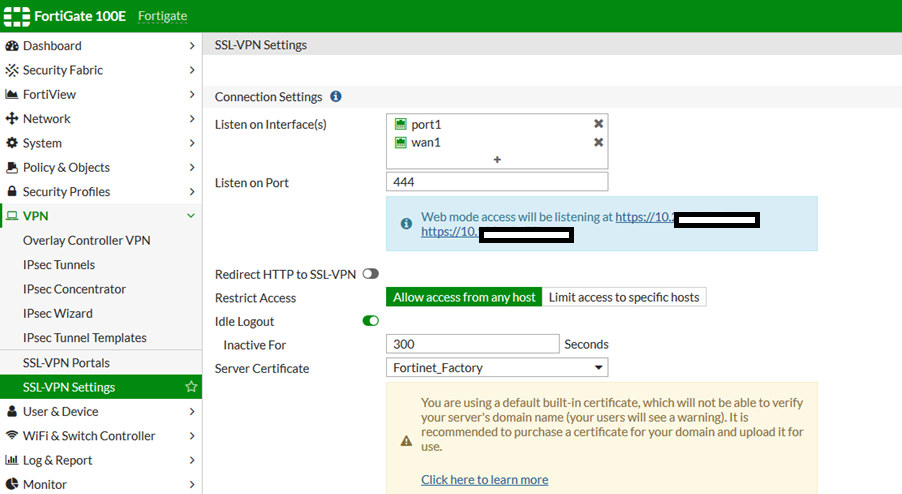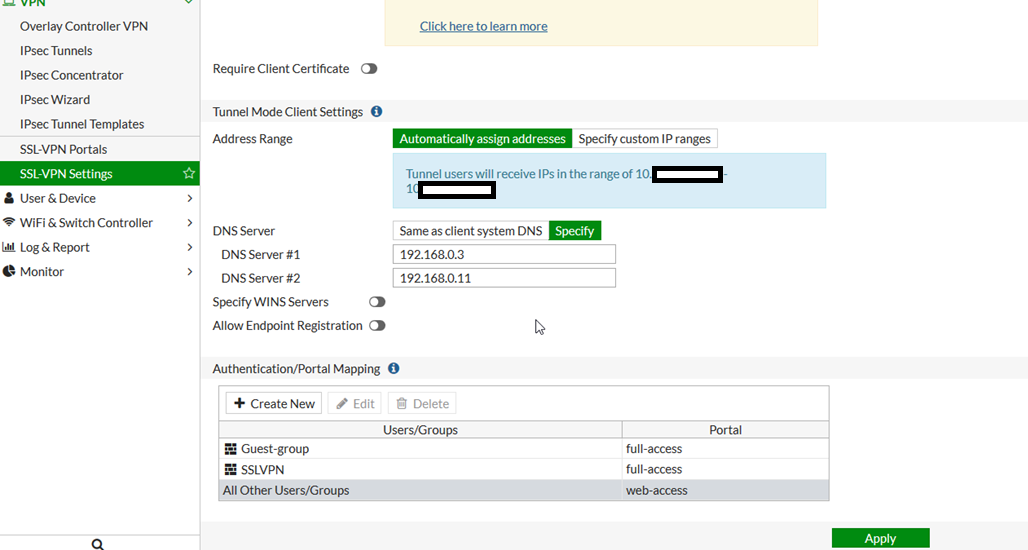- Forums
- Knowledge Base
- Customer Service
- FortiGate
- FortiClient
- FortiAP
- FortiAnalyzer
- FortiADC
- FortiAuthenticator
- FortiBridge
- FortiCache
- FortiCarrier
- FortiCASB
- FortiConnect
- FortiConverter
- FortiCNP
- FortiDAST
- FortiDDoS
- FortiDB
- FortiDNS
- FortiDeceptor
- FortiDevSec
- FortiDirector
- FortiEDR
- FortiExtender
- FortiGate Cloud
- FortiGuard
- FortiHypervisor
- FortiInsight
- FortiIsolator
- FortiMail
- FortiManager
- FortiMonitor
- FortiNAC
- FortiNAC-F
- FortiNDR (on-premise)
- FortiNDRCloud
- FortiPAM
- FortiPortal
- FortiProxy
- FortiRecon
- FortiRecorder
- FortiSandbox
- FortiSASE
- FortiScan
- FortiSIEM
- FortiSOAR
- FortiSwitch
- FortiTester
- FortiToken
- FortiVoice
- FortiWAN
- FortiWeb
- Wireless Controller
- RMA Information and Announcements
- FortiCloud Products
- ZTNA
- 4D Documents
- Customer Service
- Community Groups
- Blogs
- Fortinet Community
- Knowledge Base
- FortiGate
- Technical Tip: How to enable SSL VPN Access for tw...
- Subscribe to RSS Feed
- Mark as New
- Mark as Read
- Bookmark
- Subscribe
- Printer Friendly Page
- Report Inappropriate Content
Created on
12-04-2015
05:26 PM
Edited on
09-03-2023
11:10 PM
By
![]() Jean-Philippe_P
Jean-Philippe_P
Description
This article describes how to enable 2 SSL VPN access using a browser through 2 or more WAN Links available on the infrastructure.
Solution


edit 1
set source-interface "wan1"
set source-address "all"
set groups "Guest-group"
set portal "full-access"
next
edit 2
set groups "SSLVPN"
set portal "full-access"
next
end
end
config vpn ssl settings
set servercert "Fortinet_Factory"
set tunnel-ip-pools "SSLVPN_TUNNEL_ADDR1"
set tunnel-ipv6-pools "SSLVPN_TUNNEL_IPv6_ADDR1"
set dns-suffix "global.local"
set dns-server1 192.168.0.3
set dns-server2 192.168.0.11
set port 444
set source-interface "port1" "wan1"
set source-address "all"
set source-address6 "all"
set default-portal "web-access"
config authentication-rule
edit 1
set source-interface "wan1"
set source-address "all"
set groups "Guest-group"
set portal "full-access"
next
edit 2
set groups "SSLVPN"
set portal "full-access"
next
end
end
Related Articles:
Technical Tip: SSL VPN Redundancy.
Technical Tip: SSL VPN with multiple links not able to login Error: Permission Denied.
The Fortinet Security Fabric brings together the concepts of convergence and consolidation to provide comprehensive cybersecurity protection for all users, devices, and applications and across all network edges.
Copyright 2024 Fortinet, Inc. All Rights Reserved.